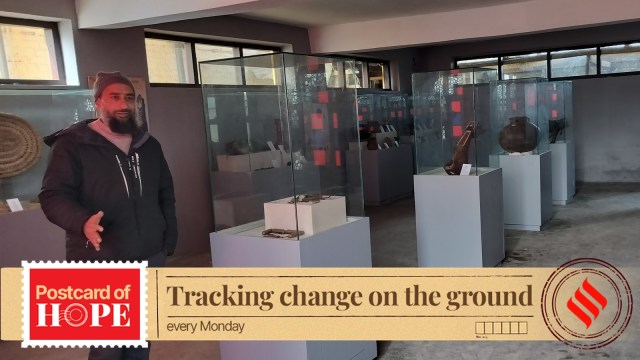
Located in a grand building on the outskirts of Sopore, Muzamil Bashir proudly showcased a detailed two-foot-long wooden artefact. “It looks like an ear dangler, which was used to adorn the rooftops of elite houses in the past. Nowadays, they are no longer in use,” he explained.
This artefact is one of the thousands housed in Meeras Mahal, the first major private museum in Jammu and Kashmir, which showcases the cultural heritage of the region. Bashir serves as the president of Meeras Mahal Trust, the organization that operates the museum.
For twenty years, his aunt, Atiqa Bano, tirelessly collected artefacts from villages in Jammu, Kashmir, and Ladakh, spanning from Gurez to Poonch to Leh. Her extensive collection is now being exhibited in the museum, which opened to the public last month. The three-storey museum contains 7,000 artefacts, including jewelry, pottery, relics of grass craftsmanship, and traditional, intricate, and rare woodwork of Kashmir.
“Every piece in this museum has a history and a story behind it,” said Bashir, who accompanied Bano on almost every expedition. “It has been a challenging task, one that only she could have undertaken.”
Bano believed that one cannot move forward without acknowledging the past. Her passion for collecting historical artefacts developed during her time as the Director of Libraries and Research in Jammu and Kashmir. After her retirement in 2001, she devoted her time and energy to preserving relics.
“I don’t believe there is a village in the Valley that we have not visited in search of these artefacts,” said Bashir. “She was old, but her passion never waned.”
Recalling an incident from the early 2000s, Bashir recounted Bano’s determination to travel to Gurez, a remote area on the Line of Control. Even officials avoided the area due to the risk of cross-border firing and mortar shells.
In addition to old musical instruments, rare hand-written manuscripts, and 400-year-old earthen pots, Bano collected terracotta tiles. She displayed a few hundred artefacts in a 20-foot by 12-foot room in the College of Education that she ran after retirement. As more people visited, she was inspired to continue her search. By 2016, she had collected around 7,000 artefacts, which she displayed in several hostel rooms of her college.
Bano passed away at the age of 77 in 2017, and it was years later that her dream of establishing a museum became a reality. The SPAN Foundation, a non-profit organization focused on the preservation of cultural heritage, and the Kashmir chapter of the Indian National Trust for Art and Cultural Heritage (INTACH) collaborated to transform the college hostel into a modern museum building inspired by traditional Kashmiri architecture.
“I could not have imagined a better project to be involved in,” said Jaspreet Kaur, trustee of the SPAN Foundation. “Atiqa Bano lived a remarkable and fascinating life. Her most notable achievement was the creation of a vast collection of artefacts through door-to-door collections. Through her collection and cataloging, she ensured the preservation of crafts and artefacts of Kashmir.”
While a large number of artefacts are currently on display at the museum, there are still hundreds waiting to be exhibited.






